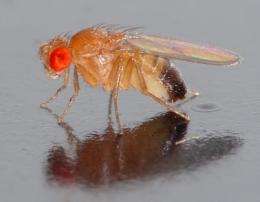Study of fruit fly chromosomes improves understanding of evolution, fertility

(Phys.org) -- The propagation of every animal on the planet is the result of sexual activity between males and females of a given species. But how did things get this way? Why two sexes instead of one? Why are sperm necessary for reproduction and how did they evolve?
These as-yet-unresolved issues fascinate Timothy Karr, a developmental geneticist and evolutionary biologist at Arizona State University’s Biodesign Institute. To probe them, he uses a common fruit fly, Drosophila melanogaster an organism that has provided science with an enormous treasure-trove of genetic information.
“My research focuses on the evolution of sex and in gamete function,” Karr says. “I focus primarily on the sperm side of the sexual equation. I’m interested in how they originated and how they are maintained in populations.”
Karr’s current study, in collaboration with researchers at the University of Chicago, recently appeared in the journal BMC Biology. The study reexamines an earlier paper that analyzed the sex chromosomes of fruit flies during spermatogenesis – the process that produces mature sperm from germ cells.
While the previous paper, by Lyudmila M Mikhaylova and Dmitry I Nurminsky, argued against the silencing of sex-linked genes on the X chromosome in Drosophila during meiosis a process referred to as Meiotic Sex Chromosome Inactivation (MSCI) – the reanalysis presented by Karr suggests MSCI is indeed occurring.
The work sheds new light on the evolution of sperm structure and function, through an analysis of Drosophila genes and gene products. As Karr explains, the research has important implications for humans as well: “The more direct, biomedical aspect is that when we learn about the function of a gene that encodes a protein in Drosophila sperm, we can immediately see if there’s a relationship between these genes and their functions and known problems with fertility in humans.”
Super Fly
Perhaps no other model organism has yielded more insights into human genetics than the tiny fruit fly Drosophila melanogaster. In 1906, Thomas Hunt Morgan of Columbia University began work on D. melanogaster, (one of over 1500 species contained in the Drosophila genus) capitalizing on the species’ ease of breeding, rapid generation time and ability to readily produce genetic mutants for study. Morgan’s efforts with Drosophila led to the identification of chromosomes as the vector of inheritance for genes, and earned him the 1933 Nobel Prize in Medicine.
Drosophila are yellow-brown in color, have reddish eyes and transverse black rings across their abdomen (see Figure 1). Females are about 2.5 millimeters long, while males are slightly smaller and may be easily identified by their darker color.
Most importantly, the similarity in the genetic systems of fruit flies and other eukaryotic organisms including humans makes these model organisms extremely useful analogues for the study of common genetic processes including transcription and translation.
Roughly 75 percent of known human disease genes have recognizable correlates in the fruit fly genome and 50 percent of fly protein sequences have mammalian homologs. (The complete genome of D. melanogaster was completed in 2000.)
Chromosomes: genetic storehouses
Humans have 23 pairs of chromosomes, or 46 chromosomes in all. Of these, 44 are known as autosomes and consist of matched pairs of chromosomes, known as homologous chromosomes. Each homologous chromosome contains the same set of genes in the same locations along the chromosome, though they may appear in differing alleles, which can affect the passing of genetic traits.
The current study however, focuses not on the autosomes but on the remaining pair of chromosomes, known as sex chromosomes. Females contain two X chromosomes, which are homologous, as in the case of the autosomes. By contrast, males are identified as having one X chromosome and one (much smaller) Y chromosome.
While drosophila only have a total of 4 chromosomes, they too display sexual dimorphism, with females carrying the double X chromosomes and males carrying XY. The two X chromosomes in female fruit flies, as in mammals, make them a homozygous sex as compared with the XY condition in males, known as heterozygous.
“There are certain aspects to the composition of these sex chromosomes that have intrigued evolutionary biologists for a long time,” Karr notes. One such issue involves an apparent reduction in the number or the level of expression of sex-linked genes on the X chromosome during spermatogenesis. It is believed that this reduction or silencing of genes on the X chromosome may have profound implications for the evolution of sex chromosomes.
During meiotic development of a sperm cell, nature attempts to compensate for the fact that females have two X chromosomes and therefore enjoy a numbers advantage in terms of genes, compared with males. To overcome the bias for female X-linked genes, the X chromosome undergoes inactivation during meiotic sexual differentiation of male gametes, resulting in an underrepresentation of sex-specific genes on the X chromosome. Some of these genes, which may be beneficial to males, are moved from the X chromosome, to the autosomes, where they may be expressed.
The relocation of male-biased genes to the autosomes may be due to a selective advantage favoring genes that move off the X chromosome and therefore avoid X-inactivation during meiosis. Such theories remain controversial however, as statistical analyses are used to evaluate gene frequencies and expression levels, making the proper categorization of genes particularly challenging. “The data we create and generate to support our ideas and hypotheses are messy, there’s noise in them,” Karr says. “Such noise is inherent in the history of evolution.”
In addition to the steady stream of insights into chromosome evolution, Drosophila are being used as a genetic model for a variety of human diseases including Alzheimer's, neurodegenerative disorders, Parkinson's, Huntington's, as well as extending knowledge of the underlying mechanisms involved in aging, oxidative stress, immunity, diabetes, and cancer.
Provided by Arizona State University


















